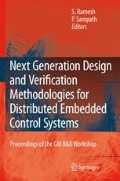Model-based development of embedded real-time systems is aimed at elevating the level of abstraction at which these systems are designed, analyzed, validated, coded, and tested. The use of a coherent multi-dimensional model across all development phases can enable model-based design to generate systems that are correct by construction. However, current code generation capabilities are usually limited to uni-processor targets and to a limited range of operating environments. SysWeaver (previously called “Time Weaver”) is a model-based development tool that includes a flexible “syscode” generation scheme for distributed real-time systems that can be easily tailored to a wide range of target platforms.We present our work on creating an interoperable toolchain to automatically generate complete run-time code using models. Thetoolchain includes a simulation tool (Matlab)anditscodegenerator(Embedded Coder) along with SysWeaver. In this chain, the functional aspects of the system are specified in Simulink, Matlab’s modeling language, and translated into a SysWeaver model to be enhanced with timing information, the target hardware model and its communication dependencies. The final run-time code is then generated, automatically integrating the functional code generated with Embedded Coder and SysWeaver’s syscode. This syscode includes OS interfacing and network communication code with predictable timing behavior that can be verified at design time. Experiments with multi-node targets with end-to-end timing constraints in an automotive system show that many aspects of syscode and functional code generation can be automated.
Access this chapter
Tax calculation will be finalised at checkout
Purchases are for personal use only
Preview
Unable to display preview. Download preview PDF.
References
“Adaptive Real-Time Systems for Quality of Service Management”, Technical Report, Euro-pean Union ARTIST Project, March 2003. http://www.artist-embedded.org/.
G.A. Agha and W. Kim. Actors: A unifying model for parallel and distributed computing. Journal of Systems Architecture, 45:1263-1277, 1999.
B. Boehm, “Tutorial: Software Risk Management”, Washington, DC, IEEE Computer Society Press.
Greg Bollela, Ben Brosgol, Peter Dibble, Steve Fur, James Gosling, David Hardin, Mark Turn-bull, Rudy Belliardi, Doug Locke, Scott Robbins, Pratik Solanki, and Dionisio de Niz. The Real-Time Specification for Java. Addision-Wesley, 2001.
Kevin Bradley. A framework for incorporating real-time analysis into system design processes. Ph.D. Dissertation, Department of Electrical and Computer Engineering, Carnegie Mellon Uni-versity, 1998.
J. Davis II. et al. Overview of the Ptolemy project. Technical Report M99/37, UC Berkeley, Dept EECS, 1999.
Dionisio de Niz and Raj Rajkumar. Chocolate: A reservation-based real-time java environment on windows/NT. In Proceedings of the Real-Time Technology and Applications Symposium, Washington D.C., May 2000.
P.H. Feiler, Bruce Lewis, Steve Vestal, “Improving Predictability in Embedded Real-Time Sys-tems”, Technical Report, CMU/SEI-2000-SR-011, Software Engineering Institute, December 2000.
C.C. Howell, “Building Dependable Systems: The Power of Negative Thinking”, Tutorial given at 2002 International Conference on Dependable Systems & Networks, IEEE Computer Society.
J. Krueger, S. Vestal, and B. Lewis. Fitting the pieces together: system/software analysis and code integration using Meta-H. In IEEE 17th Annual Digital Avionics Systems Conference, November 1998.
K. Lieberherr. Demeter and Aspect-Oriented Programming. In STJA’97 Conference, Septem- ber 1997.
Chris Lanfear and Steve Balaccco. The embedded software strategic market intelligence program 2001/2002—volume iv: Embedded operating systems, software development tools, design automation tools, and test automation tools, February 2002.
E.A. Lee. What’s Ahead for Embedded Software? Computer, 1, 2000.
Jun Li, Dependency tracking in real-time fault-tolerant systems. Ph.D. Dissertation, Depart-ment of Electrical and Computer Engineering, Carnegie Mellon University, 2000.
Klein M.H. et al. A Practitioners’ Handbook for Real-Time Analysis: Guide to Rate Monotonic Analysis for Real-Time Systems. Kluwer Academic Publishers, 1993.
Priya Narasimhan. Transparent Fault-Tolerance for CORBA. Technical report, Department of Electrical and Computer Engineering, University of California, Santa Barbara, 1999.
Network Reliability Interoperability Council V, Data Reporting and Analysis for Packet Switching, Final Report, Focus Group 2 Subcommittee 2.B2.
B. Nielsen and G. Agha. Towards reusable real-time objects. Annals of Software Engineer- ing1999.
H. Ossher and P. Tarr. Multi-dimensional separation of concerns in hyperspace. Technical Report RC21452, IBM T.J. Watson Research Center, April 1999.
S.L. Pfleeger and C.C. Howell “The Case For Constructing an Effective and Efficient Assur- ance Argument Framework”.
Lui Sha, Ragunathan Rajkumar, and John Lehoczky. Mode change protocols for priority-driven pre-emptive scheduling. In The Real-Time Systems Symposium, 1989.
Mary Shaw and David Garlan. Software Architecture: Perspectives on an Emerging Discipline. Prentice Hall, 1996.
D.B. Stewart, R.A.Volpe, and P.K. Khosla. Design of dynamically reconfigurable real-time software using port-based objects. IEEE Transactions on Software Engineering, 23, 1997.
Peri Tarr, Harold Ossher, William Harrison, and Jr. Stanley M. Sutton. N degrees of separation: multi-dimensional separation of concerns. In International Conference on Software Engineer-ing, pages 107-119, 1999.
Jim Turley. Embedded Processors, January 2002.
Steve Vestal. Mode changes in a real-time architecture description language. In International Workshop on Configurable Distributed Systems, March 1994.
S. Wang and K.G. Shin. An architecture for embedded software integration using reusable com-ponents. In International Conference on Compilers, Architecture, and Synthesis for Embedded Systems, San Jose, CA, 2000.
The Esterel Synchronous Language, Esterel Technologies, www.estereltechnologies.com.
Dionisio de Niz and Raj Rajkumar, “Partitioning Bin-Packing Algorithms for Distributed Real-Time Systems”, Invited Paper, International Journal of Embedded Systems, Special Issue on Design and Verification of Real-Time Embedded Software. 2005.
Dionisio de Niz, Modeling functional and para-functional concerns in embedded real-time sys-tems, Ph.D. Dissertation, Electrical and Computer Engineering. Carnegie Mellon University, April 2004.
Dionisio de Niz and Raj Rajkumar, “Glue Code Generation: Closing the Loophole in Model-based Development”, 10th IEEE Real-Time and Embedded Technology and Applications Sym-posium (RTAS 2004), Workshop on Model-Driven Embedded Systems (MDES 2004).
Dionisio de Niz and Ragunathan Rajkumar, “Time Weaver: A Software-Through-Models Framework For Embedded Real-Time Systems”, Language Compilers and Tools For Embed-ded Systems (LCTES 2003).
Author information
Authors and Affiliations
Editor information
Editors and Affiliations
Rights and permissions
Copyright information
© 2007 Springer
About this paper
Cite this paper
Rajkumar, R. (2007). Model-Based Development of Embedded Systems: The SysWeaver Approach. In: Ramesh, S., Sampath, P. (eds) Next Generation Design and Verification Methodologies for Distributed Embedded Control Systems. Springer, Dordrecht. https://doi.org/10.1007/978-1-4020-6254-4_3
Download citation
DOI: https://doi.org/10.1007/978-1-4020-6254-4_3
Publisher Name: Springer, Dordrecht
Print ISBN: 978-1-4020-6253-7
Online ISBN: 978-1-4020-6254-4
eBook Packages: EngineeringEngineering (R0)

